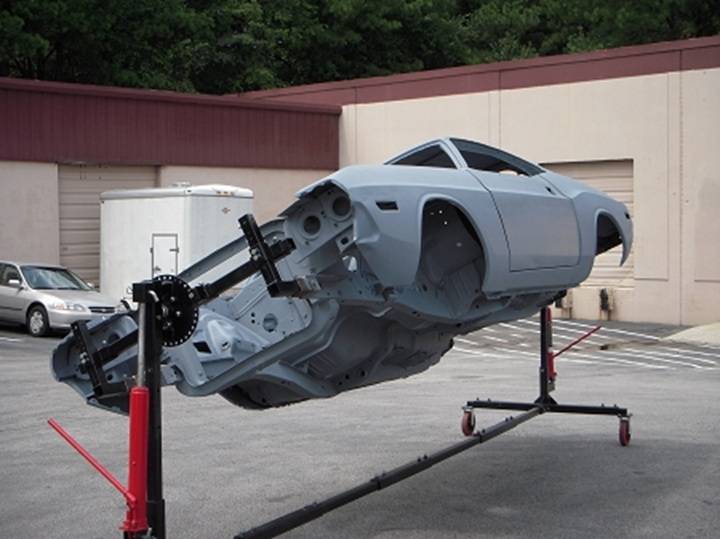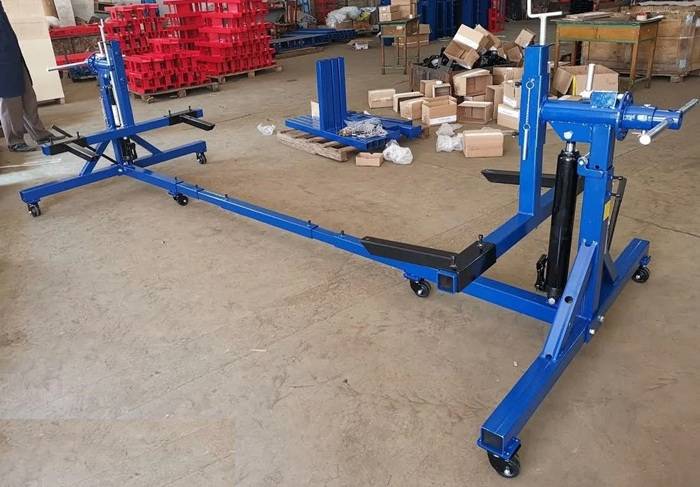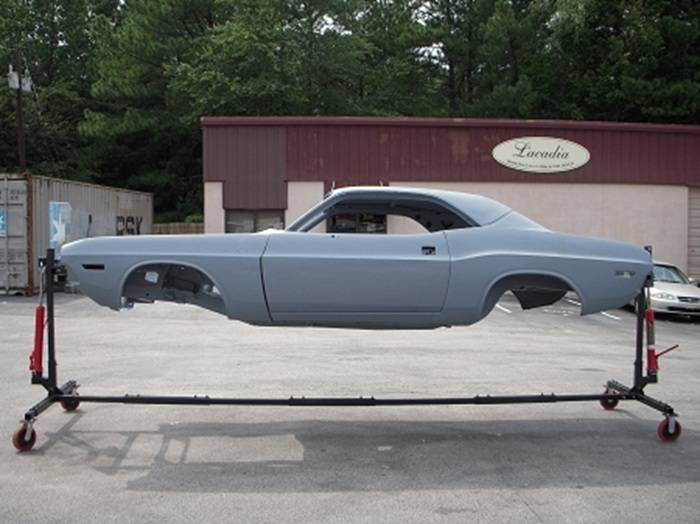Every restorer knows the struggle. Rust hides under the frame. Welds are hard to reach. Paint flakes off in corners you cannot touch. Working underneath a car on jack stands is backbreaking and risky. The solution is simple yet revolutionary. The car rotisserie.
A car rotisserie holds a vehicle body like a giant spit. It allows you to rotate it 360 degrees. It makes the underside as easy to reach as the hood. It transforms restoration from a painful crawl to a comfortable upright job.
This blog is the complete guide to the car rotisserie. What it is. How it works. Why do restorers use it? What it costs. And why it has become one of the most respected tools in the world of classic car rebuilding.
What Is a Car Rotisserie?
The Definition
A car rotisserie is a steel frame with rotating ends. The body shell mounts at the front and rear. Once balanced, the entire car can spin in mid-air. It locks securely at any angle.
The Purpose
The purpose is simple. Access. With a rotisserie, you can reach every surface. You can weld, sandblast, clean, or paint without strain. It makes restoration safer and more precise.
History of the Car Rotisserie
Early Methods
Before rotisseries, mechanics used jack stands, ramps, and pits. These methods gave limited access. Work was slow and uncomfortable. Welding upside down was common. Sandblasting was messy. Many restorers injured their backs.
The Birth of the Rotisserie
In the 1960s, hobbyists began building makeshift rotating frames. These were crude but effective. By the 1980s, manufacturers saw the demand. They designed adjustable, heavy-duty rotisseries for shops. Over time, these tools became standard equipment.
Modern Evolution
Today’s car rotisserie is engineered with precision. They include hydraulic lifts, locking systems, and caster wheels. Some even use electric motors for easy turning. What started as homemade rigs is now professional-grade equipment trusted worldwide.
Why Restorers Use a Car Rotisserie
Safety
Working under a car on stands is dangerous. A rotisserie holds the shell with steel beams. It locks in place. It reduces collapse risks.
Comfort
Instead of lying on cold floors, restorers stand. They rotate the car until the area is at eye level. No more twisted backs or strained necks.
Speed
Jobs that once took days now take hours. Sandblasting the underside. Spraying primer. Welding seams. A rotisserie cuts time dramatically.
Quality
Access equals quality. Clean welds. Smooth paint coverage. Thorough rust removal. Every detail is easier when the car is at the perfect angle.
Types of Car Rotisseries
Manual Car Rotisserie
Manual versions use pivot points or hand cranks. They require careful balancing. They are affordable and simple. Best for hobbyists.
Hydraulic Car Rotisserie
Hydraulic systems lift and rotate using jacks. They make adjustments smoother. They handle heavier vehicles. A favorite in professional shops.
Electric Car Rotisserie
Electric motors rotate the car with a button. These are high-end, efficient, and designed for constant shop use. They are the ultimate convenience.
Car Rotisserie vs Other Lifting Methods
Floor Jacks and Stands
Cheap but unsafe. Limited access. Uncomfortable. Only works for small jobs.
Two-Post Lifts
Good for mechanics but not for restorers. The underside is still blocked by arms. Cars cannot be rotated.
Pits
Used in old garages. Expensive to build. Limited to one working angle.
Rotisserie
Full rotation. Complete access. Safer and faster. Superior for restoration tasks.
Building vs Buying a Car Rotisserie
Buying
- Professionally designed.
- Tested for safety.
- Adjustable arms for many cars.
- Price range: $1,000 to $5,000.
Building
- Cheap if you have welding skills.
- Fully customizable.
- Requires strong steel and knowledge of balance.
- Must be tested carefully for safety.
Design Features of a Car Rotisserie
Steel Frame
Made of heavy-duty steel. Rated for 3,000 lbs or more.
Rotating Mounts
Allow full spin. Lock securely at any angle.
Adjustable Arms
Extend and retract to fit different models. Muscle cars, classics, or trucks.
Locking Mechanisms
Crucial for safety. Prevent unwanted spins during work.
Mobility
Most models have caster wheels. You can roll the car across the workshop.
How to Use a Car Rotisserie
Step One: Strip the Car
Remove engine, transmission, and suspension. Only the shell remains.
Step Two: Mounting
Attach front and rear to the stands with strong brackets.
Step Three: Balance
Adjust until weight is centered. Balance ensures smooth rotation.
Step Four: Rotation
Turn slowly. Lock into place at the desired angle. Begin welding, blasting, or painting.
Real-World Uses
Rust Removal
Rust hides in floor pans and frame rails. A car rotisserie allows complete cleaning and treatment.
Welding
Seams and patch panels are welded flat instead of upside down. Stronger and neater results.
Sandblasting
Rotating reduces wasted effort. No crawling under falling grit.
Painting
Full underside painting is possible. Show cars often have mirror-finish undersides. Achievable only with rotisserie access.
Benefits of a Car Rotisserie
- Saves time.
- Safer than stands.
- Reduces fatigue.
- Improves work quality.
- Adds professional appeal to any shop.
Challenges and Risks
- Expensive for beginners.
- Takes up shop space.
- Requires stripping the car.
- Poor balance can be dangerous.
Cost of Car Rotisseries
Typical Prices
- Manual: $1,000 – $1,800.
- Hydraulic: $2,000 – $3,500.
- Electric: $3,500 – $5,000+.
Extra Costs
- Shipping heavy steel.
- Brackets for rare models.
- Safety gear like straps.
- Optional upgrades like hydraulic jacks.
Car Rotisserie in Restoration Culture
Classic Car Restorers
Mustang, Camaro, and Chevelle restorers rely on rotisseries. Rust repair is precise. Undersides look factory-new.
Hot Rod Builders
Custom frames are welded cleaner. Show builds look flawless from every angle.
Truck Restorers
Trucks are heavy. Hydraulic rotisseries handle the weight with ease.
Maintenance of a Car Rotisserie
- Grease joints regularly.
- Inspect bolts and welds often.
- Replace worn caster wheels.
- Store indoors to prevent rust.
Future of Car Rotisseries
The future includes motorized balancing, digital sensors, and automated locking. Smart rotisseries may adjust themselves. Professional shops may adopt electric systems as standard.
Extended Pros and Cons
Advantages
- Safer than stands.
- Provides 360-degree access.
- Saves restoration time.
- Reduces physical strain.
- Professional appearance.
Disadvantages
- Cost is high for hobbyists.
- Needs space.
- DIY builds require caution.
- Cannot hold fully assembled cars.
Case Studies
Classic Mustang Restoration
A restorer in Texas used a rotisserie to repair floor pans. Without it, welding upside down would have been sloppy. With it, panels were welded flat and clean.
Show Car Underside Finish
A hot rod builder in California used a rotisserie to polish and paint the underside of a 1932 Ford. Judges awarded extra points for detail.
Truck Restoration
A hydraulic rotisserie supported a Chevy truck body weighing over 3,000 lbs. Without it, rust repair would have been nearly impossible.
FAQs
What is a car rotisserie used for?
It allows a vehicle body to rotate fully, making restoration easier.
How much weight can a car rotisserie hold?
Most support 3,000 lbs. Heavy-duty models hold more.
Can I build my own car rotisserie?
Yes. With welding skills and strong steel, safety is critical.
Is a car rotisserie worth buying?
Yes. It saves time, improves safety, and increases restoration quality.
Do I need to strip the car before using it?
Yes. Engines, transmissions, and heavy parts must be removed.
The car rotisserie is one of the most valuable tools in restoration. It takes the hardest jobs and makes them simple. It gives access to every inch of the vehicle. It improves quality. It saves time. It keeps the restorer safe.
From classic cars to hot rods and trucks, the car rotisserie has become essential. What began as a homemade rig is now a professional standard. And as technology evolves, it will only get better. For anyone serious about restoration, the car rotisserie is not optional. It is essential.



